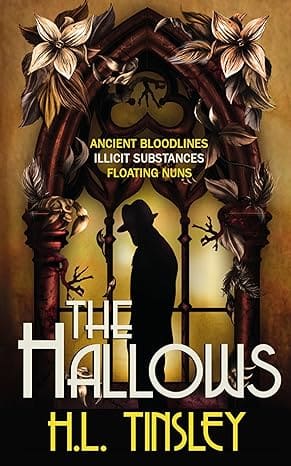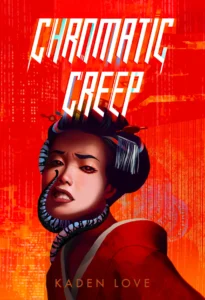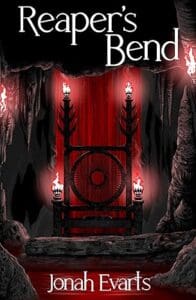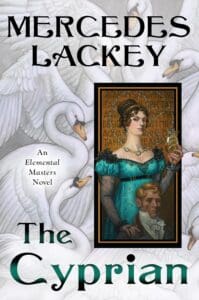
Drugs, nuns and secrets – no, not your average weekend night out but the return of the Princess of Grimdark.
Synopsis
The Hallow serum was once sacred to the Auld Bloods. Used to gain access to their lost ancestral powers, now it is regulated and administered by the powerful Providence Company. Evolved from the echelons of the Auld Church, the company exists to maintain the balance between faith, science and politics.
But keeping the peace between humans and Auld Bloods isn’t easy. Taking Hallow comes at a price. Providence Company Assessor Cam must deal with backstreet bootleggers, burnt-out addicts and floating nuns that won’t stay on the ground.
When a string of Auld Blood deaths appear to have been caused by a corrupted batch of Hallow, Cam begins to suspect all may not be as it seems. Bodies are piling up. Someone is hiding something, and the consequences are becoming monstrous.
Review
With her grimdark, noirish gaslamp fantasy series The Vanguard Chronicles, author H. L. Tinsley, in just two books, established herself for me as one of the premier fantasy writers of the dark and the sordid and the beautiful. With the kind of prose you want to interrupt a wedding to crow about (“Are there are any reasons these two should not be married?” “I don’t know, have they read Tinsley yet”?) – equal parts brilliantly witty and movingly poetic – and characters you come to deeply care for in a grim world you become obsessed by, these novels were real statements of intent and I loved them dearly.
So when I heard she was staying in her grim urban fantasy niche with her newest novel but adding a golden age, 1920s-style flair to the noir and throwing in “illicit substances and floating nuns”, I was more excited than a shark at a pool party.
Reader, she has delivered. The Hallows is a remarkably, ingeniously creative take on a terrifying magic drug and the trauma it causes and the moving (and often, frankly, hilarious) ways that a city’s inhabitants must build their lives around it.
The drug in question is Hallow (you didn’t see that one coming) and it’s a magical serum used by a race of human-like people called the Auld Bloods to amp up their natural powers to useful and occasionally awe-inspiring levels. The Auld Bloods, who pretty much look like us, live in more or less harmony with humans – with a sinisterly named corporate entity called the Providence Company controlling the administering of the drug and its symbiotic partner The Auld Church acting as the religious front. Teams made up of people called assessors act as roving agents of the Company, making sure that illegal uses of the drug don’t cause havoc in the city.
One such assessor, our protagonist Camellia – despite the name a man, as all members of his team are named after flowers (daffodil, forget-me-not etc, a nice touch that gives it that 20s feel) – stumbles across a series of Hallow-related deaths that don’t make any sense and, against the dangerous background of the first Auld Blood being elected to a position of power in the city, must investigate what is really going on.
The first thing to highlight is what a fantastic concept Tinsley has alighted on with her magical, addictive drug. Essentially, the drug amplifies the existing powers of Auld Bloods, which are split across numerous types. Half the fun of this book is discovering what all the intriguing names mean. Some, like Feathers, or Stouts or Sirens, you can probably guess. Others are a little more mysterious until they are revealed (I definitely didn’t correctly guess what flickers were, and I won’t be telling you what my first guess was). The catch, though is that eventually, after years of using the drug, their bodies undergo irreversible changes – horns might sprout, or worse limbs might disappear and reappear in very unhelpful parts of the body. For assessors like Camellia, this means forced retirement. But you never know when this life-changing event is going to happen.
This idea of a drug as the key to godlike powers while also being a life-ruining curse is one that pervades the novel with a sense of poignant tragedy at some times and utter terror at others, and Tinsley wrings all the creativity and emotion out of it that you would hope for. It also results in some enjoyably barmy moments. A classic car ride with a floating nun tied down with weights? Tick. A drug addict floating to the top of ceiling where he can’t be caught? Tick. Tinsley wrings the hilarious and the tragic out of this idea to the extent you’d expect for an author for whom wit and woe are one and the same.
Tinsley is also interested in other themes in this book, too. There’s tension between the humans and the Auld Bloods in the city – funding to deal with the worst effects of the drug are being threatened. There’s very much a fear of the “other” on display here. There’s also an intriguing thread of the harms and benefits of science, as our main man Camellia was once a researcher in the uses of the drug, something which comes back to bite him in a big way.
But it’s in the character development that Tinsley, as usual, finds some of her greatest triumphs. Camellia has a will-they-won’t-they relationship with June, one of the nuns who are about to commit themselves for a lifetime to the Auld Church despite Cam’s feelings for her. The scenes of them taking a picnic, enjoying a moment of peace while knowing they have no future – poignant, moving, brutal but hopeful – are some of the best character scenes you will read all year. Then there’s the spirited nun Sister Ramona – she who was driving the car with the floating nun I referenced earlier – who in the brief scenes she’s in will quickly steal your heart. And for all the tragedy in this chaotic world, at its heart is a message of hope, and unexpected redemption where you’ll least expect it.
Few authors can capture the holy trinity of prose, character and worldbuilding like Tinsley. The Hallows is a magnificent, witty, bizarre and heart-breaking read in a world you won’t want to leave. Just like the drug-addicted denizens of this remarkable story, I never wanted to comedown.







Leave a Reply